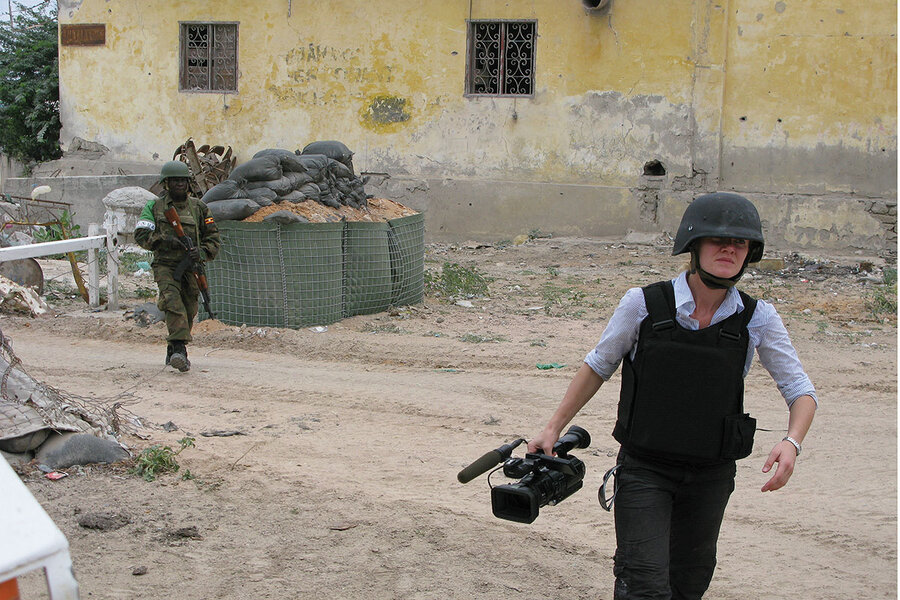Women war correspondents marched to their own drummer
Loading...
War reporter Jane Ferguson explains that she wrote her memoir, “No Ordinary Assignment,” to answer a question she’s often asked: Why does she do this dangerous work? Ferguson has covered conflicts and humanitarian crises in Afghanistan, Somalia, Syria, and more, at great personal risk. Her compelling and candid book links her determination to succeed as a journalist to her difficult, lonely childhood on a small farm in Northern Ireland.
An engaging new biography of photographer and reporter Dickey Chapelle explores similar territory. “First to the Front: The Untold Story of Dickey Chapelle, Trailblazing Female War Correspondent” by Lorissa Rinehart also features an extraordinarily courageous woman who had few female role models. Chapelle began working during World War II, and she died while on assignment in Vietnam.
One wonders whether Ferguson, a special correspondent for “PBS NewsHour” and a contributor to The New Yorker, is familiar with Chapelle’s story; while Rinehart believes that Chapelle should be a household name, she isn’t widely known. Ferguson, born in 1984, was instead emboldened by reading the biography of pioneering war reporter Martha Gellhorn and by seeing women on TV reporting from around the globe for the BBC.
Looking back, Ferguson believes that her severe upbringing prepared her for such an unusual career. “I was never comforted, so I learned to live with fear as a kind of presence, under the weight of which I grew impenetrably strong,” she recalls.
Ferguson left the United Kingdom to study Arabic in Yemen, a country she grew to love. From there she landed a job as a reporter for an English-language daily newspaper in Dubai, United Arab Emirates, but after covering sports and business, she had an epiphany: “I wanted to be out on the road, telling stories that really mattered.” She began traveling on her own to some of the world’s most dangerous locations, working as a freelancer. She says that being “disposable and brave” were her two primary assets early in her career.
The author recounts occasions when she smuggled herself into unsafe places, as she did at the start of Syria’s brutal civil war, in order to shine a light on what was happening. One of the things that stands out is her compassion. “The thing that truly spoke to me, that I adored most about my work, was talking to civilians and finding the humanity in troubled places,” she writes.
Ferguson is open about the agonies of her job. She recalls filming in a makeshift hospital in Mogadishu in 2010, when Somalia was wracked by violence and famine. “To stand in a hospital with a camera and not a stethoscope, to offer no tangible help to the person suffering in front of you, to voyeuristically witness their suffering – all of this is grotesque,” she writes. She has struggled to make peace with the limitations of her vocation while still believing in its importance. As for her role, she writes, “In all honesty, the only question I can answer is, Did I do my part?” Readers are likely to come away convinced that she did.
Chapelle’s courage was also remarkable. She once wrote, “Good correspondents are created out of the simple compulsion to go see for themselves what is happening.” That compulsion led her to embed herself with American service members during World War II; she was the first American woman to cover the Pacific Fleet, photographing the action at Iwo Jima and Okinawa. Her presence was so surprising that the men often demanded, “How the hell did you get here?”
With her male colleagues more likely to get the big assignments, Chapelle at first had trouble making a living. But she was dogged both in pursuing editors and in chasing stories, from the Pacific theater in World War II to conflicts in Algeria, Laos, and Cuba. Her articles and photographs eventually appeared in Reader’s Digest, National Geographic, and Life, among others.
Like Ferguson, Chapelle often found herself in dangerous situations. She was arrested by Soviet border guards during Hungary’s revolution in 1956 and held in solitary confinement in Budapest for five weeks. She was traumatized by the experience, but within a few months she’d resumed taking dangerous combat assignments.
She didn’t always maintain journalistic distance. During eight months embedded with a Cuban exile militia in Miami, Chapelle seemed to be as much participant as reporter. Rinehart describes her living under an assumed name and helping the militia build an arsenal. It’s hard to imagine a journalist today blurring such lines.
Chapelle learned to parachute so she could jump out of planes with troops in Vietnam. Rinehart writes, “She came under fire nine times, endured clouds of mosquitoes so thick they clouded her glasses, and watched deadly snakes slither by her boots as she stood motionless for fear the smallest sound might alert the enemy to their location.” In November 1965, marching with Marines in Viet Cong territory, Chapelle was struck by an improvised explosive device. She was 47 and the first female American journalist to be killed while covering combat. She had often said, “When I die, I want to be on patrol with the Marines.”








